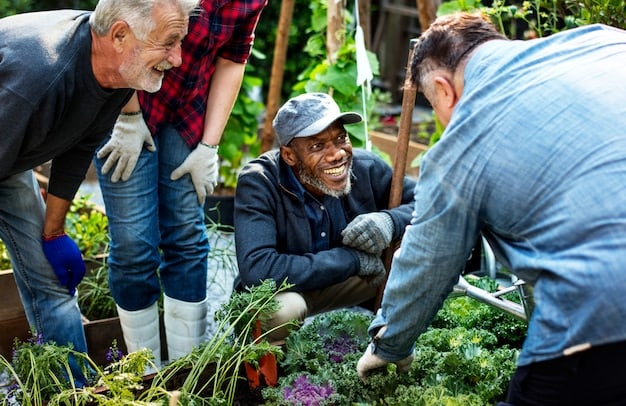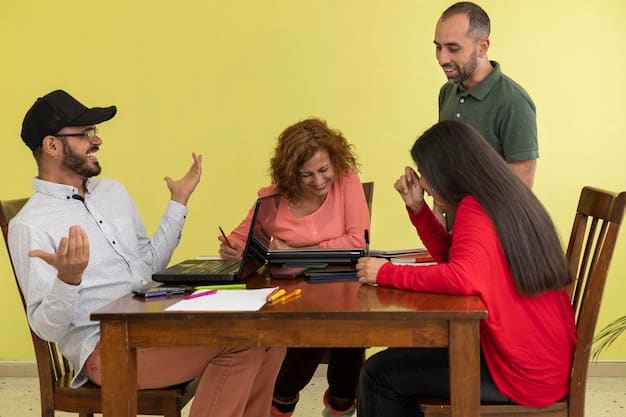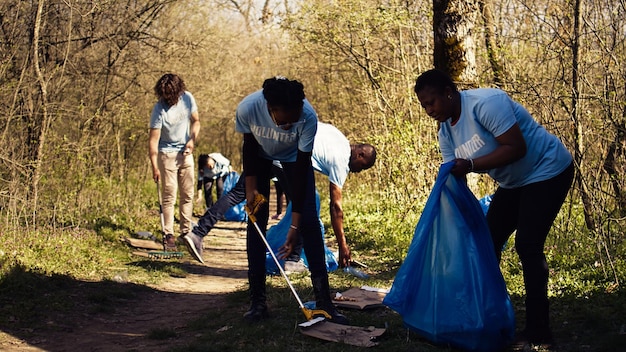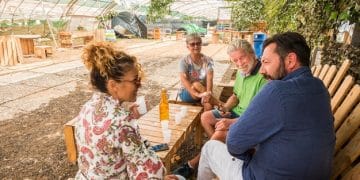The Power of Collaboration: Community Partnerships for Sustainable Development

The power of collaboration lies in its ability to leverage diverse resources and expertise through community partnerships, driving innovation and fostering sustainable development initiatives that address complex social and environmental challenges.
In today’s interconnected world, the concept of working together to achieve common goals has never been more critical. The power of collaboration, especially through community partnerships, is a driving force behind sustainable development, enabling communities to address complex challenges and create lasting positive change.
Understanding the Essence of Community Partnerships
Community partnerships are collaborative relationships between various stakeholders, including local residents, non-profit organizations, businesses, government agencies, and educational institutions. These partnerships pool resources, knowledge, and expertise to address specific community needs and promote sustainable development.
The essence of community partnerships lies in their ability to foster a sense of shared responsibility and ownership. When individuals and organizations come together with a common vision, they can achieve far more than they could on their own.
Key Characteristics of Effective Community Partnerships
- Shared Vision: A clear and mutually agreed-upon understanding of the goals and objectives.
- Trust and Respect: Open communication, transparency, and mutual respect among partners.
- Diverse Representation: Inclusion of diverse perspectives and voices from all segments of the community.
- Resource Sharing: Pooling financial, human, and material resources to maximize impact.
Effective community partnerships are built on a foundation of trust, respect, and shared vision. They recognize the unique strengths and contributions of each partner, fostering a collaborative environment where everyone can thrive.

The Role of Collaboration in Sustainable Development Goals
The United Nations Sustainable Development Goals (SDGs) provide a global framework for addressing pressing social, economic, and environmental challenges. Collaboration is essential for achieving these goals, as it enables communities to leverage diverse resources and expertise to create innovative solutions.
Community partnerships play a crucial role in advancing the SDGs at the local level. By working together, stakeholders can develop and implement targeted strategies that address specific community needs while contributing to the global sustainable development agenda.
How Collaboration Drives Progress Towards the SDGs
- Goal 1: No Poverty – Collaborative initiatives can create job opportunities, provide access to education and healthcare, and promote economic empowerment.
- Goal 4: Quality Education – Partnerships between schools, community organizations, and businesses can enhance educational programs and provide students with the skills they need to succeed.
- Goal 11: Sustainable Cities and Communities – Collaborative projects can improve infrastructure, promote sustainable transportation, and create vibrant public spaces.
For example, a community partnership focused on reducing poverty might involve a local non-profit organization providing job training, a business offering employment opportunities, and a government agency providing financial assistance. By working together, these partners can create a comprehensive support system that empowers individuals to lift themselves out of poverty.
Building Strong and Inclusive Community Partnerships
Creating strong and inclusive community partnerships requires a deliberate and thoughtful approach. It involves identifying key stakeholders, establishing clear communication channels, and fostering a culture of trust and respect.
Inclusive partnerships ensure that all voices are heard and that decisions are made in a fair and transparent manner. This approach is essential for building community ownership and ensuring the long-term sustainability of collaborative initiatives.

Strategies for Building Effective Partnerships
- Identify Key Stakeholders: Identify individuals and organizations that have a vested interest in the community and the resources and expertise to contribute.
- Establish Clear Communication Channels: Create open and transparent communication channels to facilitate information sharing and collaborative decision-making.
- Foster a Culture of Trust and Respect: Promote a culture of trust and respect among partners, valuing diverse perspectives and recognizing individual contributions.
Building diverse partnerships also ensures that the partnership benefits from multiple perspectives and experiences. Incorporating different backgrounds, knowledge, and skills into the partnership will strengthen any project.
Overcoming Challenges in Community Collaboration
Community collaboration is not without its challenges. Differences in organizational cultures, conflicting priorities, and limited resources can all hinder the effectiveness of partnerships. However, by addressing these challenges proactively, communities can build stronger and more resilient collaborations.
One common challenge is the “not invented here” syndrome, which refers to the tendency of organizations to resist adopting ideas or practices from outside sources. Overcoming this syndrome requires a willingness to learn from others and to embrace new approaches.
Common Challenges and Strategies for Addressing Them
- Conflicting Priorities: Establish a clear and shared vision to align partner priorities.
- Limited Resources: Pool resources and seek external funding opportunities.
- Communication Barriers: Establish clear communication protocols and utilize effective communication tools.
Another common issue is developing buy-in throughout the community and partner organizations. Transparency in decision-making and action is important for ensuring members and the community feel involved.
Measuring the Impact of Community Partnerships
Measuring the impact of community partnerships is essential for demonstrating their value and ensuring their long-term sustainability. By tracking key indicators and documenting success stories, communities can showcase the positive outcomes of their collaborative efforts.
Effective impact measurement requires a clear understanding of the partnership’s goals and objectives. It also involves collecting data from multiple sources and using appropriate evaluation methods.
Key Indicators for Measuring Impact
- Community Well-being: Improvements in health, education, and economic outcomes.
- Environmental Sustainability: Reductions in pollution, waste, and resource consumption.
- Social Equity: Increased access to opportunities for underserved populations.
Impact measurement should be an inclusive and participatory process, involving all partners in the data collection and analysis. By working together to assess their progress, partners can identify areas for improvement and refine their strategies to maximize impact.
Case Studies of Successful Community Partnerships
Numerous examples around the world demonstrate the **power of collaboration** in driving sustainable development. These case studies offer valuable insights into the strategies and approaches that can lead to successful community partnerships.
One notable example is the collaboration between a local food bank and a community garden. The food bank provides funding and volunteers for the garden, while the garden provides fresh produce for the food bank’s clients. This partnership not only addresses food insecurity but also promotes healthy eating habits and community engagement.
Examples of Impactful Community Partnerships
Another successful initiative is a collaborative that sought to provide at-risk youth with skills to enter the workforce. The partnership involved job training programs, schools, mental health services, and local business leaders. After completion of the job training, the youth had access to mental health services, high school equivalency courses, and business professionals served as mentors to the youth.
Community partnerships like these are essential for creating positive change and building a more sustainable future. By recognizing the importance of collaboration and investing in strong, inclusive partnerships, communities can unlock their full potential and create lasting impact.
| Key Point | Brief Description |
|---|---|
| 🤝 Shared Vision | Establishes common goals for effective partnership. |
| 🌱 Sustainable Goals | Contributes to the United Nations SDGs locally. |
| 🗣️ Open Communication | Fosters trust and transparency among partners. |
| 📊 Impact Measurement | Tracks outcomes for long-term sustainability. |
Frequently Asked Questions
▼
Successful partnerships require a shared vision, trust, open communication, mutual respect, and the active participation of all partners in the decision-making processes to reach community objectives.
▼
Community partnerships enhance sustainability by pooling diverse resources and expertise to address social, economic, and environmental challenges more effectively than individual efforts.
▼
Common challenges include conflicting priorities, limited resources, communication barriers, and resistance to external ideas; these can be addressed through clear vision and inclusive action.
▼
The impact should be measured by assessing improvements in community well-being, documenting environmental sustainability, promoting social equity, and involving all the partners in the data analysis process.
▼
Local governments act as facilitators, providing funding, resources, and policy support for collaborative initiatives, connecting community organizations with opportunities and needed services.
Conclusion
In conclusion, the power of collaboration through community partnerships is undeniable. By fostering shared responsibility, leveraging diverse resources, and addressing challenges collectively, communities can drive sustainable development and create a brighter future for all. Embracing collaboration is not just a strategy; it is a necessity for building thriving, resilient, and equitable communities.





